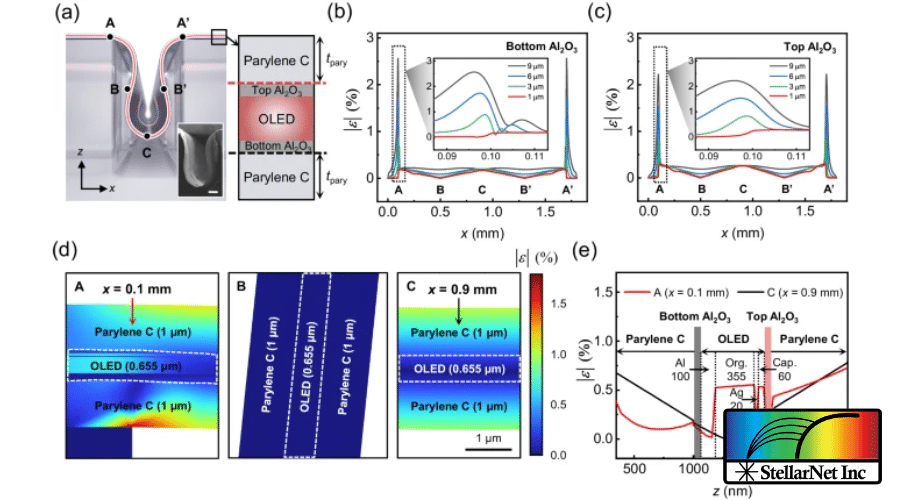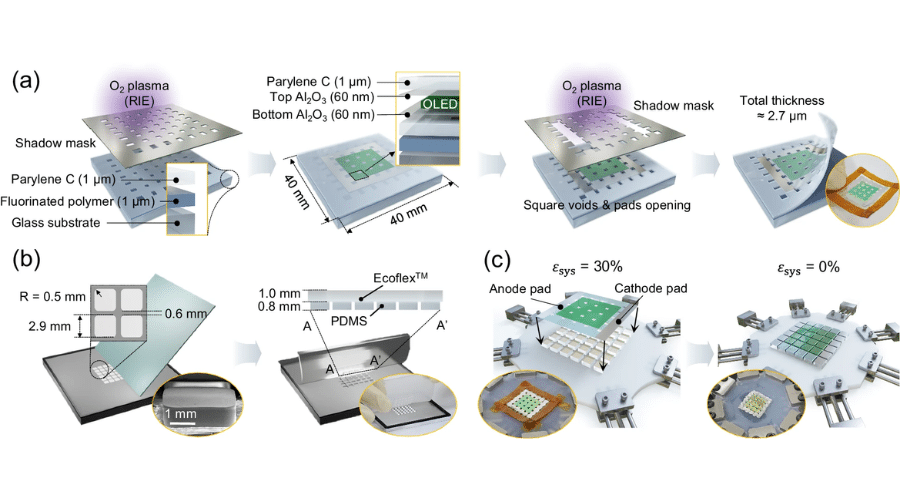Donggyun Lee, Su-Bon Kim, Taehyun Kim, Dongho Choi, Jee Hoon Sim, Woochan Lee, Hyunsu Cho, Jong-Heon Yang, Junho Kim, Sangin Hahn, Hanul Moon & Seunghyup Yoo
04 June 2024 | Nature Communications
Abstract
Stretchable organic light-emitting diodes (OLEDs) have emerged as promising optoelectronic devices with exceptional degree of freedom in form factors. However, stretching OLEDs often results in a reduction in the geometrical fill factor (FF), that is the ratio of an active area to the total area, thereby limiting their potential for a broad range of applications. To overcome these challenges, we propose a three-dimensional (3D) architecture adopting a hidden active area that serves a dual role as both an emitting area and an interconnector. For this purpose, an ultrathin OLED is first attached to a 3D rigid island array structure through quadaxial stretching for precise, deformation-free alignment. A portion of the ultrathin OLED is concealed by letting it ‘fold in’ between the adjacent islands in the initial, non-stretched condition and gradually surfaces to the top upon stretching. This design enables the proposed stretchable OLEDs to exhibit a relatively high FF not only in the initial state but also after substantial deformation corresponding to a 30% biaxial system strain. Moreover, passive-matrix OLED displays that utilize this architecture are shown to be configurable for compensation of post-stretch resolution loss, demonstrating the efficacy of the proposed approach in realizing the full potential of stretchable OLEDs.
Introduction
Stretchable organic light-emitting diodes (OLEDs), capable of bending, twisting, and conforming to curved surfaces, have emerged as innovative optoelectronic devices for next-generation displays and lighting applications. Their exceptional form factor advantages have propelled them beyond the traditional use of rigid or flexible OLEDs, poised to open up diverse possibilities for non-conventional applications such as wearable displays as well as body-attachable health-monitoring or phototherapeutic devices. The automotive industry may also benefit from this technology, as it offers opportunities to create a new generation of in-car displays with enhanced safety and decorative features. With its cutting-edge form factor and versatile applications, stretchable OLEDs have captured the attention of the organic electronics field in pursuit of the ultimate form factor.
In this work, we propose a solution to achieve rigid-island-based stretchable light sources with the initial and post-stretch FF that are both unprecedentedly high. To this end, we exploit the high degree of mechanical flexibility and areal light-emitting characteristics of ultrathin OLEDs in a three-dimensional structure. Specifically, we replace serpentine interconnectors with an ultra-thin hidden active area (HAA). It is hidden in the initial unstretched state by ‘folding inward’ along the negative z-axis between adjacent islands of a 3D rigid island array at a very tight bending radius, thereby allowing a very high FF to be achieved in the initial, unstretched state. This ultrathin HAA emerges to the surfaces upon stretching, alleviating the typical sharp drop in FF upon stretching or, optionally, offering a means to compensate stretching-induced resolution decrease. Unlike previous approaches adopting compact initial integration structures, hidden interconnectors, or hidden active devices, the HAA in the present work is a part of a whole ultrathin OLED transferred to the islands, and thus, its full area can ultimately function as an active light-emitting region, enabling very high FF even in the stretched state.
Schematic diagrams presented in Fig. 2 summarize the step-by-step fabrication process for the proposed stretchable OLED with an HAA structure in three main steps:
a The fabrication process of the square void patterned Parylene C sandwiched OLED. From left to right, it illustrates the bottom Parylene C patterning, OLED deposition, top Parylene C patterning, and the ultrathin OLED peeling off process. (Inset: A photograph of the free-standing ultrathin OLED). b The process includes the fabrication of the patterned hybrid elastomer using doctor blading. (Inset: A SEM image of the patterned PDMS island and a photograph of the patterned hybrid elastomer). c The alignment and adhesion process of the Parylene C sandwiched OLED and patterned hybrid elastomer using a quadaxial stage. (Inset: Photographs of the transferred ultrathin OLED onto the pre-stretched patterned hybrid elastomer and the stretchable OLED after releasing the pre-strain).
…the angular electroluminance (EL) spectra were measured with a customized measurement system consisting of a fiber optic spectrometer (BW_UVNb, StellarNet)…







